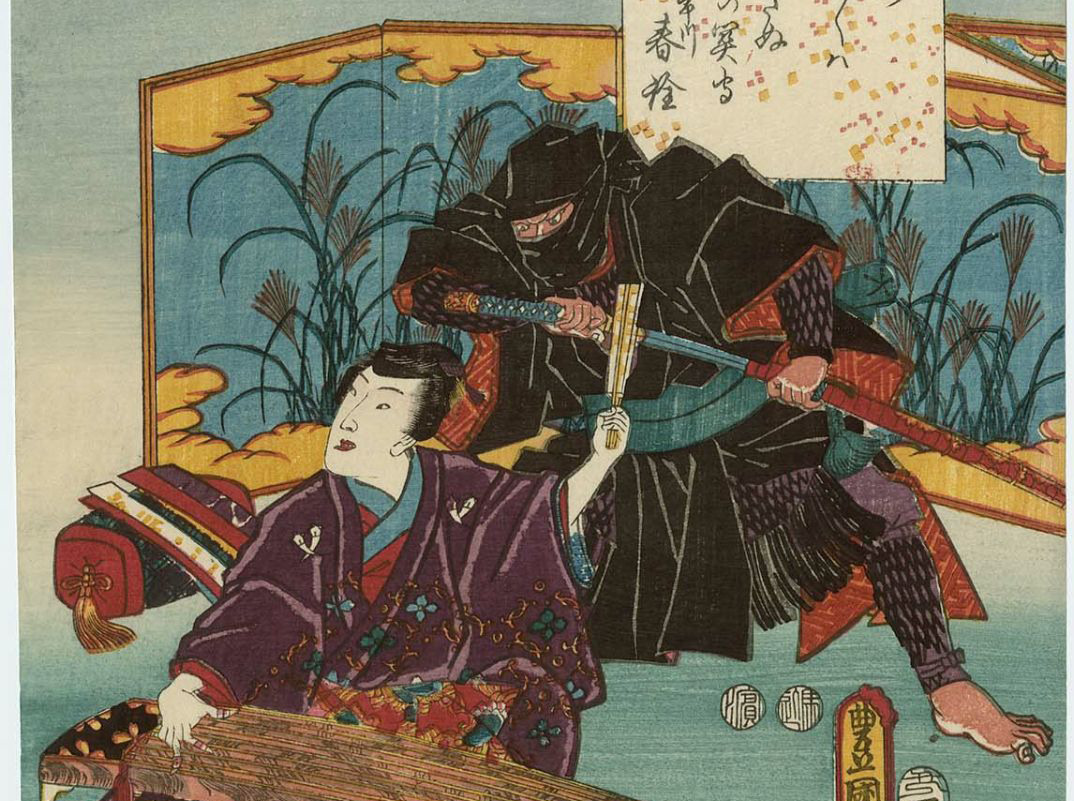A ninja and Prince Hikaru Genji by Utagawa Kunisada. Ch. 12, Suma, from the series The Color Print Contest of a Modern Genji (Ima Genji nishiki-e awase). 1853. Cropped.
The historical existence of ninjas is veiled in mystery. There are academics who debate whether they even truly existed or were simply just mythical creations. The term “ninja” doesn’t appear in historical texts until the 19th century. However, their impact on Japanese history endures. Folklore often attributes them with extraordinary powers which further enhances their mystique. The majority of ninja narratives originate from documents penned long after their prime in the 14th century. Despite the exaggerations in these accounts, they do preserve an element of truth. With that in mind, let’s proceed.
The ninjas of legend were covert agents skilled in espionage, sabotage, and guerrilla warfare. They were trained as assassins and mercenaries and usually belonged to the lower classes of Japanese society. Ninjas tended to hide their identities and stay in the shadows to do ‘dirty work’ for political rivals.
The Iga and Koga ninja clans are two of the most legendary ninja clans in the history of Japan. Known as shinobi, meaning “those who act in stealth”, these clans specialized in unconventional warfare, espionage, and assassination. Both clans consisted of several families, each represented by a jonin (literally an “upper man”), who was responsible for hiring out ninja.

The Iga Ninja Clan
The Iga ninja clan originated in the Iga Province, in the area around the towns of Iga and Ueno in Mie Prefecture. They trained in the local mountains and forests, honing their secret art and skills over many centuries The Iga ninja were experts in disguise, escape, concealment, explosives, poison, unarmed combat, and a multitude of weaponry. The most famous of the Iga ninja was undoubtedly Hattori Hanzo, who saved the life of Tokugawa Ieyasu. When Ieyasu became shogun in 1603, he employed the Iga ninja as guards for Edo Castle (now part of the Imperial Palace in Tokyo) as well as to supply him with intelligence much like modern-day spies.
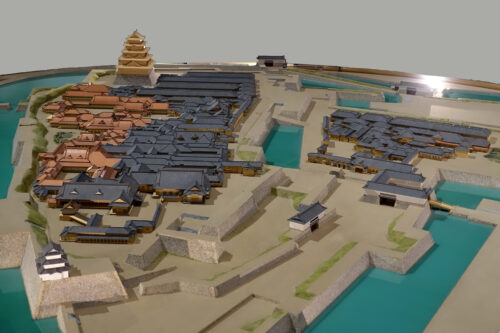
The Koga Ninja Clan
Rivaling the Iga were the Koga ninja clan in Shiga Prefecture. Although not as well known, they were said to have used both stealth and deception to mask their true size and power. The Koka region (the ninja tend to be rendered in English as Koga, while the region is Koka) was strategically important, situated on the ancient Tokaido Road, the main route from Kyoto to Edo (modern-day Tokyo). The Koka area was said to have been filled with hidden ninja villages deep in the mountains.
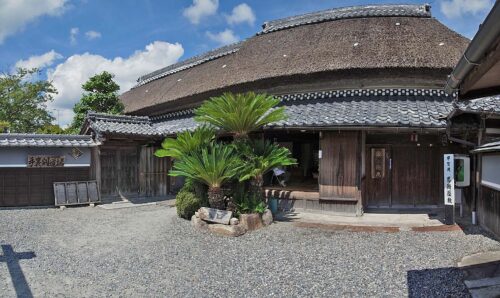
Weapons of the Ninjas
The Iga and Koga ninjas utilized a variety of weapons. The katana was often their preferred choice, although short words and daggers were used. The katana was often worn on the back. It was a versatile tool, serving purposes beyond combat. In dark environments, the scabbard could be extended for probing. It could also be leaned against a wall to provide a foothold using the sword guard (tsuba). Additionally, the katana could be used to disorient enemies by filling the top of the scabbard with a mixture of red pepper, dust, and iron filings, which would fly into the enemy’s eyes when the sword was drawn, allowing for a lethal strike.
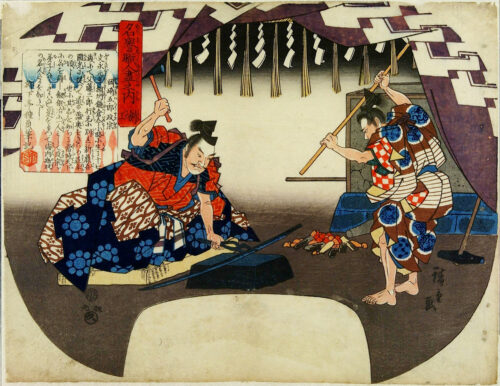
Ninjas also employed an assortment of darts, spikes, knives, and sharp, star-shaped discs known as shuriken. These could be thrown in any direction and were a key part of the ninja’s arsenal. Bows were used for precision shooting. Some ninja bows were intentionally made smaller than the traditional yumi (longbow). The chain and sickle (kusarigama), consisting of a weight on one end of a chain and a sickle (kama) on the other, was another weapon used by ninjas. The weight could be swung to injure or disable an opponent, while the sickle was used for close-range attacks.
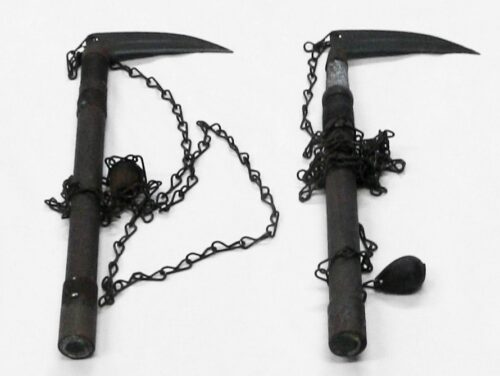
By the time of the Mongol invasions in the 13th century, explosives introduced from China were known in Japan. Ninjas later adopted hand-held bombs and grenades. Soft-cased bombs were designed to release smoke or poison gas, along with fragmentation explosives filled with iron or ceramic shrapnel.
Ninjas were associated with a wide range of weapons beyond the common ones. These included poison, makibishi (caltrops), shikomizue (cane swords), land mines, fukiya (blowguns), poisoned darts, acid-spurting tubes, and firearms. The happō, a small eggshell filled with metsubushi (blinding powder), was also used to aid in escape.
Disguise & Concealment
The Iga and Koga ninja clans trained extensively in the arts of disguise and concealment, which were crucial aspects of their stealth techniques. The ninjas were trained to blend into their surroundings by disguising themselves as common people, such as monks, merchants, or farmers. This allowed them to move freely without arousing suspicion. They also used various forms of deception to mask their true size and power. Ninjas were not always solitary operatives. Teamwork techniques were a part of their strategies.
The ninjas were experts in the art of concealment, which involved hiding in plain sight and moving silently without being detected They trained in the local mountains and forests, honing their skills over many centuries. These environments provided the ideal hidden training ground. The ninjas were also trained in escape techniques, which involved using smoke bombs, traps, and other tools to evade capture.
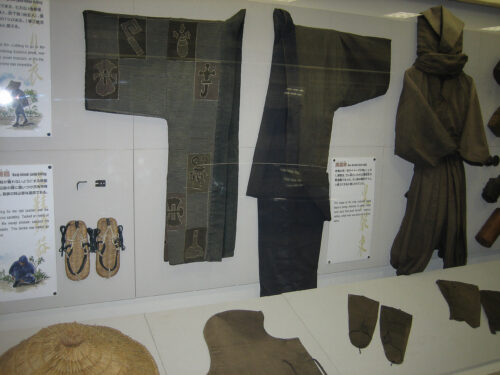
The Iga and Koga ninja clans were known for their ability to scale walls, which was a crucial part of their stealth techniques. They employed a variety of tools and techniques. They used scaling hooks, which were ropes with hooks that could be thrown over a wall or onto a roof, allowing the ninja to climb up to the top. In addition, they often wore special footwear equipped with spikes on the soles, aiding them in climbing walls and trees. Similar to these foot spikes, they also used hand claws to grip surfaces while climbing. They also carried collapsible ladders made of bamboo or wood, which could be quickly assembled for scaling walls. They also employed a variety of tools to break locks, breach walls and to eavesdrop. These tools were instrumental in enabling the ninja to infiltrate enemy compounds, execute their missions, and escape undetected.
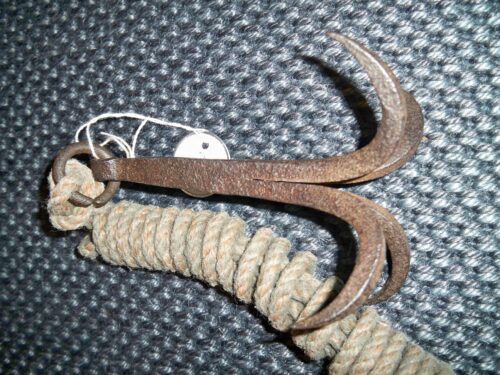
Decline of the Ninja
The Iga and Koga ninja clans faced significant challenges during the Sengoku Period (roughly 1467-1590), which was the golden age of ninjas in Japan. The alliance between the two ninja clans was terminated when Oda Nobunaga forced Koga to surrender in 1574. The Iga ninja clan faced defeat during the Tensei Iga War, which led to the dispersion of the Iga-ryu and Koka-ryu traditions across Japan as the surviving ninjas fled their homeland.
Despite these challenges, the legacy of these ninja clans continues to live on. Today, you can discover many of the secrets of the Iga and Koga ninjas at the Iga-ryu Ninja Museum in Iga City and the Koka Ninja Village in Koka. These museums offer visitors a modern look into the legendary life of a ninja.
Resources
Iga-ryu Ninja Museum
IgaNinja.jp
Koka Ninja Village
Koka.Ninpou.jp
*The views and opinions expressed on this website are solely those of the original authors and contributors. These views and opinions do not necessarily represent those of Spotter Up Magazine, the administrative staff, and/or any/all contributors to this site.

